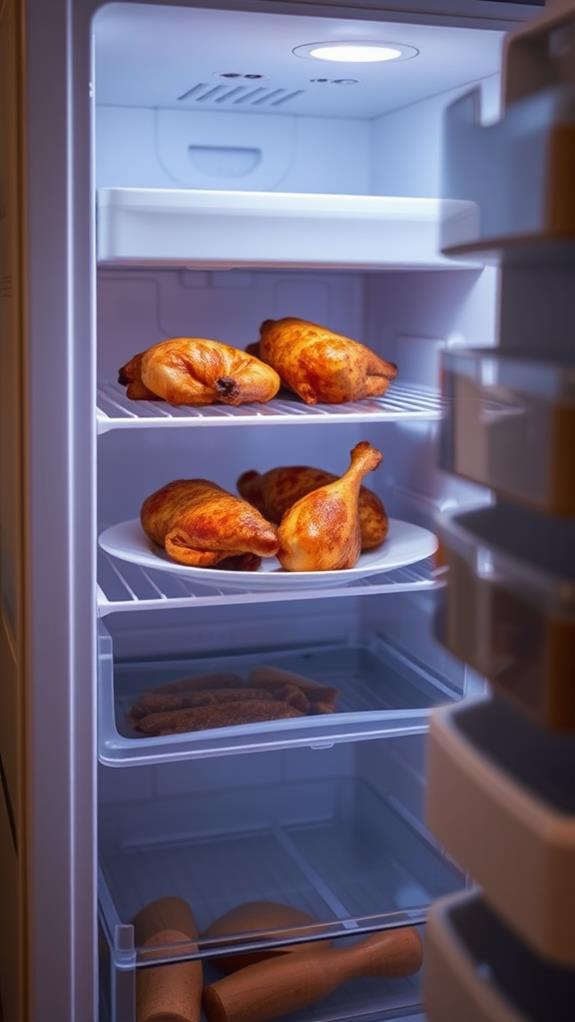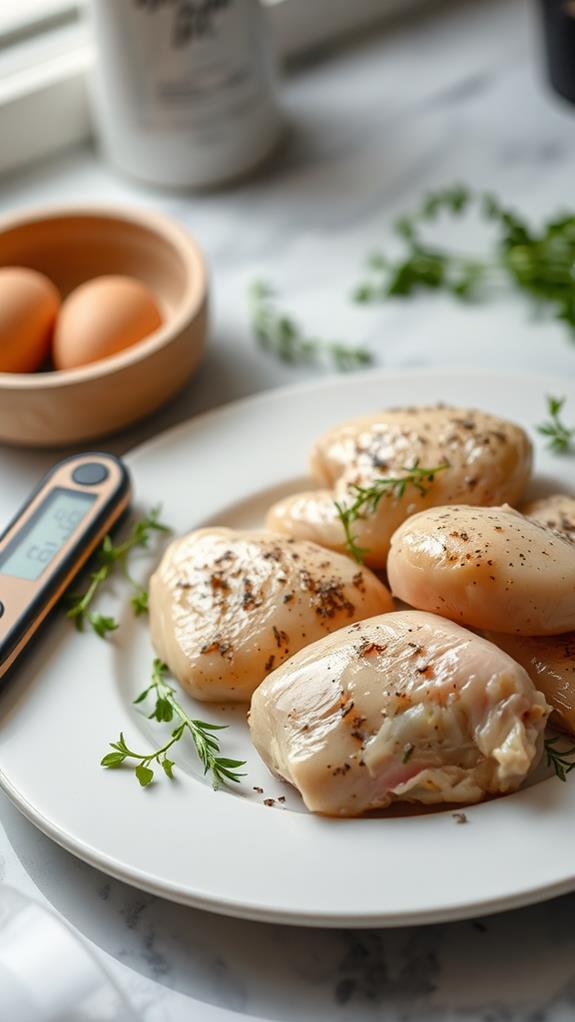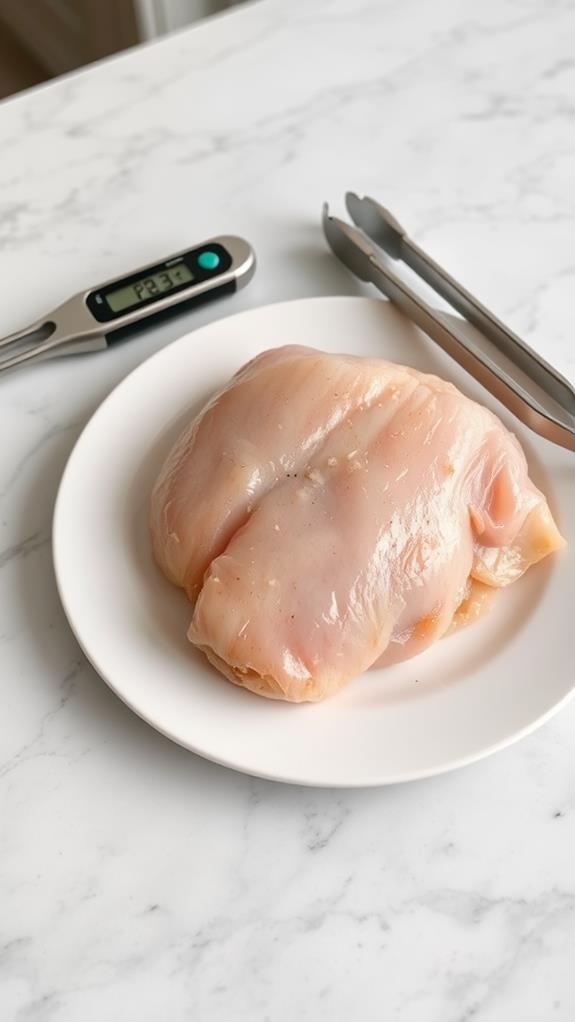Is It Safe to Eat Cold Chicken
Cold chicken is generally safe to eat if you've followed proper storage and handling procedures. You can consume it straight from the refrigerator if it's been cooked thoroughly, stored at temperatures below 40°F, and eaten within 3-4 days. Always check for signs of spoilage like odd smells, slimy texture, or discoloration before eating. Be cautious if you're pregnant, elderly, or immunocompromised, as these groups are more susceptible to foodborne illnesses. Remember to store cooked chicken within two hours of cooking (one hour if it's above 90°F) and use airtight containers or wrap it tightly. While cold chicken can be safe, understanding the nuances of food safety can help you make informed decisions about your meals.
This post may contain affiliate links. If you make a purchase through these links, I may earn a commission at no additional cost to you. Additionally, portions of this post may be generated using artificial intelligence (AI) technology. While we strive for accuracy, please be aware that AI-generated content may not always be perfect and should be fact-checked when necessary.
The Spatula Scoops
- Cold chicken is generally safe to eat if stored properly in the refrigerator below 40°F within 2 hours of cooking.
- Consume refrigerated chicken within 3-4 days and check for signs of spoilage before eating.
- Pregnant women, elderly, and immunocompromised individuals should avoid cold chicken due to increased risk of foodborne illness.
- Reheat cold chicken to an internal temperature of 165°F if uncertain about storage history or for hot dishes.
- Avoid leaving cold chicken at room temperature for more than 2 hours to prevent bacterial growth.
Understanding Cold Chicken Safety

Understanding the safety of cold chicken is crucial for anyone who enjoys leftovers or meal prepping. When you're dealing with cold chicken, you're navigating a potential minefield of foodborne illnesses. The key factor here is temperature control. Bacteria thrive in the "danger zone," which is between 40°F and 140°F (4°C to 60°C). To guarantee safety, you need to cool cooked chicken quickly and store it at or below 40°F. Similar to turkey, chicken requires proper temperature maintenance to achieve a 7-log reduction of harmful bacteria, ensuring food safety.
Time is another pivotal element. Even when refrigerated properly, cooked chicken shouldn't be kept for more than 3-4 days. This timeframe helps minimize the risk of bacterial growth. It's essential to practice proper food handling techniques, including using clean utensils and containers for storage.
When reheating cold chicken, you must confirm it reaches an internal temperature of 165°F (74°C) to kill any potential bacteria. This process, known as "thermal processing" in food safety terms, is critical for eliminating pathogens. Remember, the appearance or smell of chicken isn't always a reliable indicator of safety. Adhering to these guidelines will help you enjoy cold chicken without compromising your health.
Proper Storage Techniques
The refrigerator is your ally in keeping cold chicken safe to eat. You'll want to store your cooked chicken in the fridge within two hours of cooking, or one hour if the temperature's above 90°F (32°C). Use shallow, airtight containers or wrap the chicken tightly in aluminum foil or plastic wrap. This prevents bacterial growth and cross-contamination. Proper storage is essential to avoid the danger zone where bacteria thrive, typically between 40°F and 140°F.
Place your chicken on the bottom shelf of your refrigerator, where it's coldest. The ideal temperature for storing cold chicken is below 40°F (4°C). Don't overcrowd your fridge; proper air circulation is critical for maintaining consistent temperatures.
When it comes to shelf life, you've got a 3-4 day window to consume your refrigerated chicken. If you won't eat it within this timeframe, consider freezing it. For freezing, use freezer-safe containers or heavy-duty freezer bags, removing as much air as possible to prevent freezer burn. Frozen chicken can last up to four months.
Remember to label your containers with the date of storage. This practice, known as date marking in food safety parlance, helps you track freshness and reduce the risk of consuming spoiled chicken.
Potential Risks and Precautions

Several potential risks come with consuming cold chicken, even when it's been properly stored. The primary concern is bacterial growth, particularly Salmonella and Campylobacter, which can thrive in poultry. While refrigeration slows bacterial multiplication, it doesn't eliminate existing bacteria. Digital thermometers are essential for guaranteeing chicken has been cooked to the safe internal temperature of 165°F (75°C) before refrigeration and consumption.
You'll want to be cautious when handling cold chicken. Always check for signs of spoilage, such as an off-odor, slimy texture, or discoloration. If you notice any of these, it's best to discard the chicken. When reheating, ensure the internal temperature reaches 165°F (74°C) to kill any potential pathogens.
To minimize risks, don't leave cold chicken at room temperature for more than two hours. If you're packing it for lunch, use an insulated container with ice packs. Be mindful of cross-contamination; use separate utensils and cutting boards for raw and cooked chicken.
If you're pregnant, elderly, or have a compromised immune system, you might want to avoid cold chicken altogether. These groups are more susceptible to foodborne illnesses. By following these precautions, you can drastically reduce the risk of consuming unsafe cold chicken.
When to Reheat Chicken
Deciding when to reheat chicken depends on several factors, including personal preference, safety concerns, and the dish you're preparing. If you're consuming chicken that's been properly stored in the refrigerator, you don't always need to reheat it. However, there are instances when reheating is advisable.
You should reheat chicken if it's been sitting at room temperature for more than two hours, as this can promote bacterial growth. Additionally, if you're serving the chicken as part of a hot dish, reheating guarantees a consistent temperature throughout the meal. When incorporating cold chicken into recipes like salads or sandwiches, reheating isn't necessary.
Consider reheating if you're uncertain about the chicken's storage history or if it's been refrigerated for more than three to four days. To ensure food safety, use a meat thermometer to verify that the internal temperature reaches 165°F (74°C) during reheating. This process, known as "temperature targeting," is essential for eliminating potential pathogens. Remember, reheating chicken multiple times can affect its texture and increase the risk of foodborne illness, so it's best to reheat only what you plan to consume immediately.
Safe Handling and Consumption

Safe handling and consumption of cold chicken is essential to prevent foodborne illnesses. When you're dealing with leftover chicken, it's imperative to follow proper food safety guidelines. Always store your cooked chicken in the refrigerator within two hours of cooking, or one hour if the temperature is above 90°F. Keep it in an airtight container or wrapped tightly in plastic wrap or aluminum foil.
When you're ready to eat your cold chicken, make sure it hasn't been in the fridge for more than 3-4 days. Before consuming, check for any signs of spoilage like an off odor, slimy texture, or discoloration. If you notice any of these, it's best to discard the chicken. Always use clean utensils and surfaces when handling cold chicken to avoid cross-contamination. If you're serving the chicken in a salad or sandwich, keep it chilled until just before eating. For pregnant women, elderly individuals, or those with weakened immune systems, it's safer to reheat chicken to an internal temperature of 165°F before consumption. By following these guidelines, you'll minimize the risk of foodborne illnesses and enjoy your cold chicken safely.
Frequently Asked Questions
Can Cold Chicken Be Used in Salads Without Reheating?
Yes, you can safely use cold chicken in salads without reheating. As long as the chicken was properly cooked and stored, it's perfectly fine to serve it cold. You'll want to guarantee it's been refrigerated at 40°F or below and consumed within 3-4 days of cooking. Cold chicken can add protein and flavor to your salads, making them more nutritious and satisfying. Just remember to handle it safely, keeping it chilled until you're ready to serve your salad.
Does Marinating Cold Chicken Before Eating Affect Its Safety?
Marinating cold chicken before eating doesn't inherently affect its safety. However, you should follow proper food handling practices. Keep the chicken refrigerated while marinating, and don't reuse the marinade. If the chicken was safely cooked and properly stored, marinating won't introduce new risks. Remember, the danger zone for bacterial growth is between 40°F and 140°F. Always guarantee your chicken reaches an internal temperature of 165°F when cooking, regardless of marination. If in doubt, reheat the chicken thoroughly before consuming.
Are There Any Nutritional Differences Between Cold and Hot Chicken?
When it comes to nutritional differences between cold and hot chicken, you'll find they're minimal. The protein, fat, and calorie content remain largely unchanged. However, you might notice slight variations in texture and taste. Cold chicken can be slightly tougher and less flavorful. Curiously, some studies suggest that cooled, reheated chicken may have a lower glycemic index compared to freshly cooked chicken. This could potentially affect how your body processes the carbohydrates, but the overall nutritional impact is generally insignificant.
Can Cold Chicken Be Safely Consumed During Pregnancy?
Did you know that 1 in 10 pregnant women experience foodborne illness? When it comes to cold chicken during pregnancy, you can safely consume it if it's been properly cooked and stored. Guarantee it's been refrigerated at 40°F or below and eaten within 3-4 days of cooking. Always reheat leftovers to 165°F to kill any potential bacteria. If you're unsure about the chicken's safety, it's best to avoid it. Your health and your baby's well-being are paramount.
How Long Can Cold Chicken Sit Out at Room Temperature?
You shouldn't leave cold chicken at room temperature for more than two hours. After this time, bacteria can multiply rapidly, increasing the risk of foodborne illness. If the room is warmer than 90°F (32°C), reduce this time to one hour. To guarantee food safety, refrigerate your chicken promptly after cooking or serving. If you're unsure how long it's been out, it's best to discard it. Always prioritize food safety to protect your health.
Conclusion
You've learned that eating cold chicken can be safe if you've stored and handled it properly. Remember to refrigerate cooked chicken within two hours and consume it within 3-4 days. While cold chicken is generally safe, reheating it to 165°F (74°C) eliminates any potential bacteria. If you're unsure about the chicken's safety, it's best to err on the side of caution and discard it. By following these guidelines, you'll minimize risks and enjoy your leftover chicken worry-free.





